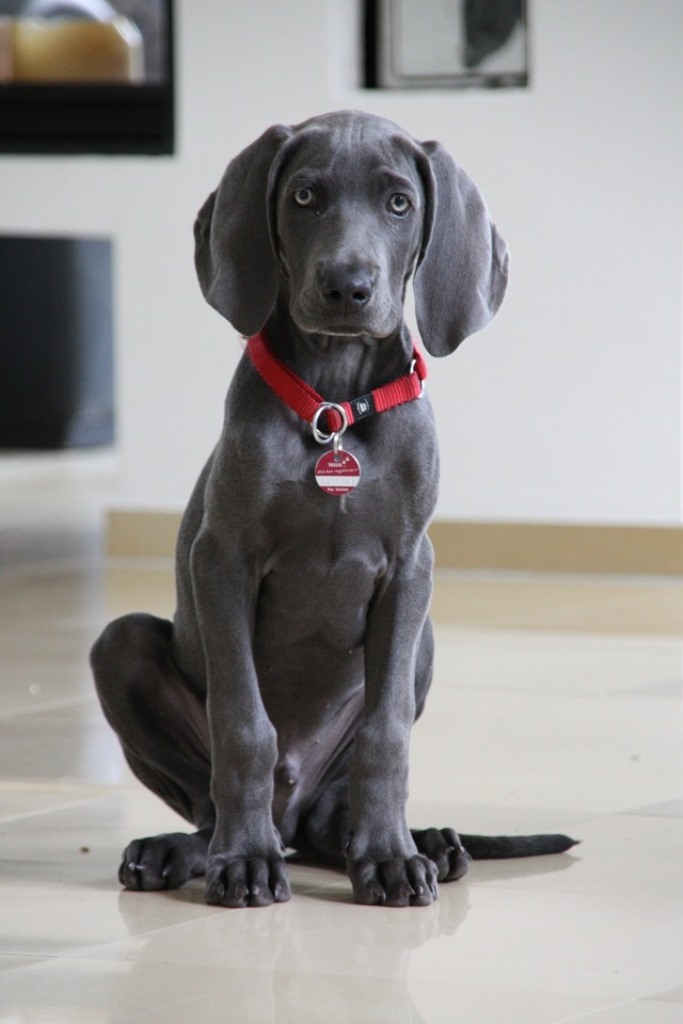
Weimaraner Dog Breed: Graceful and Loyal Companion
The origin of the Weimaraner dog breed seems to be in Germany, although there are different theses. Its name, however, was given in the 18th century, when Grand Duke Carl August of Weimar, who considered himself the king of hunters, selected this breed for hunting in the forests of Thuringia.
To preserve its morphology and aptitude, the Duke of Weimar restricted ownership of the selected subjects to members of the German breed club, and they were bred for big game hunting. Once coarse hunting disappeared, these dogs were bred for bird hunting.
In earlier times, this beautiful hunting dog, with its silver coat, was depicted in paintings by Van Dick and Van Baptiste Oudry at the feet of nobles and courtiers, or engaged in hunting activities, as early as 1600, but there is even talk of the 14th century, when its ancestor, from which today's Weimar hound, the grey dog of Saint Louis, is thought to be descended, was brought to Europe and more precisely to France by King Louis IX on his return from a crusade in the Holy Land. This dog was destined for hunting, and showed a strong attachment to its master, something we still find in the Weimar hound today.
Initially a bloodhound, it later became a hound; this characteristic makes it a versatile dog that can adapt to hunting everything from hares and partridges in the fields to woodcock in the woods. It is also capable of following the trail of a wounded deer, or signalling a wild boar by barking at rest with courage and determination.
Compared to other hunting dog breeds, it is not suited to live in kennels with the other dogs of the pack, as it develops a very strong attachment to its owner. In America, the Weimar pointer has been very successful and there are many activities in which it is involved: hunting, driving, police dog, even narcotics investigator, it is also an excellent companion dog and is very suitable for agility dogs.
Since the breed was recognised, the Weimaraner has remained a pure breed, and is considered the oldest German hunting dog, remaining pure for over 100 years.
Character of the Weimaraner dog breed

The Weimar Slinger has a very beautiful character, is sweet, loyal and devoted especially to its owner, to the point of being almost maniacal, for whom it develops a strong sense of protection. With children he is sweet and patient and plays happily.
It is a dog with a strong territoriality, which is why it is also an excellent guard dog, never aggressive, and with strangers it is initially wary, although its lively and playful nature soon makes it friends. He feels to all intents and purposes an integral part of his family unit towards which he is very protective.
His docile character makes him a very easy dog to train, but at the same time he is proud and stubborn and very determined, so it is very important to be able to keep his liveliness and his eagerness under control. You have to be firm in education, starting very early, already as a puppy.
Good socialisation, also early, both with other animals and with humans, is very important. This is to avoid problems with both people and other pets in the family, although this dog tends to be quiet, non-aggressive, docile and calm.
The Weimar pointer is a dog that cannot be alone for many hours a day, in many cases loneliness can turn into a rather obvious health problem such as separation anxiety. And this can lead him to be destructive both in the house and in the garden.
It also adapts to a flat, but it needs a lot of space, so ideally it should have a garden where it can spend several hours a day, and above all, the Weimar pointer needs a lot of exercise every day. It is primarily a hunting dog, so it needs a lot of mental and physical stimulation. A hunter owner is ideal.
Appearance of the Weimaraner dog breed

The Weimaraner is a medium to large dog, the height at withers can be as high as 70 centimetres and the male weighs 40 kilograms. The female weighs about 5 kilograms less. It is an agile, snappy dog with good musculature and a harmonious and very elegant shape. It is slender and linear with long legs, a wide ribcage and a torso that tends to narrow in the kidney area.
The head is lean with a noble and statuesque profile. The ears are of medium length, rather wide and protruding forward. The eyes, blue in the puppies, very often turn amber, maintaining their great expressiveness. The truffle is clear.
The coat may be either short or long, although the latter is rare. It is bristly, thick and even in short-haired specimens, while in long-haired specimens it is soft, smooth or wavy, with little undercoat. The colour is uniform, sometimes with a slightly lighter head and ears and all intermediate shades of silver grey, from the darkest shade of antique silver to the lightest shade of an aquamarine. The colour of the coat reflects the light and due to the difficulty of spotting it in fog, it has taken the nickname of the silver ghost.
Health and care of the Weimaraner dog breed

The Weimaraner is a robust dog of great physical endurance, with a life expectancy of up to 15 years. It can develop certain problems typical of other breeds such as hip dysplasia, retinal atrophy, hypothyroidism and stomach torsion.
As a dog that spends most of its time outdoors, it is a good idea that in addition to brushing its coat fairly often, it should be given eye and ear hygiene, as well as paws and interdigital spaces, and also a daily check-up to make sure it is free of parasites such as ticks and fleas.
As far as nutrition is concerned, if he gets the right exercise he does not tend to put on weight. An adequate diet for its muscular and tenacious physique, under veterinary control, will be important for the health and well-being of this poodle.






















